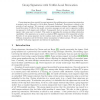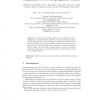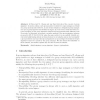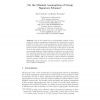110
click to vote
ESORICS
2012
Springer
13 years 2 months ago
2012
Springer
We initiate the study of unique group signature such that signatures of the same message by the same user will always have a large common component (i.e., unique identifier). It ...
PKC
2012
Springer
13 years 2 months ago
2012
Springer
We identify a potential weakness in the standard security model for dynamic group signatures which appears to have been overlooked previously. More specifically, we highlight tha...
146
click to vote
CTRSA
2012
Springer
13 years 8 months ago
2012
Springer
We study the problem of searching on encrypted data, where the search is performed using a plaintext message or a keyword, rather than a message-specific trapdoor as done by state...
103
click to vote
CISC
2008
Springer
15 years 2 months ago
2008
Springer
Anonymity is one of the main concerns in group-oriented cryptography. However, most efforts, for instance, group signatures and ring signatures, are only made to provide anonymity ...
102
click to vote
ASIACRYPT
2006
Springer
15 years 4 months ago
2006
Springer
Non-interactive zero-knowledge proofs play an essential role in many cryptographic protocols. We suggest several NIZK proof systems based on prime order groups with a bilinear map...
130
click to vote
CCS
2004
ACM
15 years 4 months ago
2004
ACM
Group signatures have recently become important for enabling privacy-preserving attestation in projects such as Microsoft's ngscb effort (formerly Palladium). Revocation is c...
131
click to vote
CTRSA
2009
Springer
15 years 4 months ago
2009
Springer
In many applications, it is desirable to work with signatures that are both short, and yet where many messages from different signers be verified very quickly. RSA signatures sati...
131
click to vote
ISW
1999
Springer
15 years 4 months ago
1999
Springer
Abstract. Group signature schemes allow a group member to anonymously sign on group’s behalf. Moreover, in case of anonymity misuse, a group authority can recover the issuer of a...
105
click to vote
INDOCRYPT
2003
Springer
15 years 5 months ago
2003
Springer
At Eurocrypt’91, Chaum and van Heyst introduced the concept of group signature. In such a scheme, each group member is allowed to sign messages on behalf of a group anonymously. ...
115
click to vote
ICICS
2004
Springer
15 years 6 months ago
2004
Springer
Abstract. One of the central lines of cryptographic research is identifying the weakest assumptions required for the construction of secure primitives. In the context of group sign...




